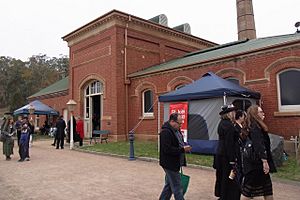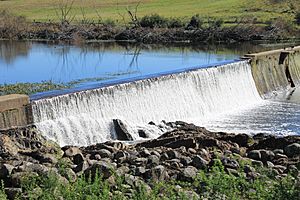Goulburn Pumping Station facts for kids
Quick facts for kids Goulburn Pumping Station |
|
|---|---|
 |
|
| Location | Wollondilly River, Goulburn, Goulburn Mulwaree Council, New South Wales, Australia |
| Built | 1885–1886 |
| Owner | Goulburn Mulwaree Council |
| Official name: Goulburn Pumping Station, Marsden Weir & Appleby Steam Engine; Goulburn Steam Museum Pump House | |
| Type | state heritage (complex / group) |
| Designated | 2 April 1999 |
| Reference no. | 356 |
| Type | Water Pump House/Pumping Station |
| Category | Utilities – Water |
| Lua error in Module:Location_map at line 420: attempt to index field 'wikibase' (a nil value). | |
The Goulburn Pumping Station is a special old building in Goulburn, New South Wales, Australia. It sits by the Wollondilly River. This place used to pump water for the city. It was built between 1885 and 1886.
Inside, you can find the amazing Appleby Steam Engine. This engine is very important. It is the only complete, working beam engine water supply system left in its original spot in the Southern Hemisphere.
Today, the pumping station is a museum called the Goulburn Historic Waterworks Museum. It is owned by the Goulburn Mulwaree Council. This historic site was added to the New South Wales State Heritage Register on 2 April 1999.
Contents
How Goulburn Got Its Water
The steam-powered pumping station was built in 1885. It was placed right next to the Wollondilly River at Marsden Weir. This station gave Goulburn its first public water supply. It started working in January 1886.
Before 1886, people in Goulburn collected water in tanks or wells. Some even bought water from people who delivered it. As the city grew, it needed a better water system.
The Rivers and Harbours Board decided to build this waterworks. It used a steam-powered beam engine to pump water. Water was lifted from the river to a special filter plant and a reservoir. From there, gravity helped the water flow to homes in the city.
The pumphouse still has its original Appleby Bros. Beam Engine pump. It also has the old Lancashire Boilers. These boilers were heated by burning wood 24 hours a day, seven days a week.
The Amazing Appleby Beam Engine
The Appleby Bros. steam engine inside the pumphouse was made in 1883. It was one of four such engines installed in pumping stations across New South Wales. The others were in Wagga Wagga, Albury, and Bathurst. The engines in Wagga Wagga and Albury were removed in 1936.
This engine is called a "beam engine" because of a large, rocking beam at the top. This beam moves back and forth. It helps transfer power from the engine's pistons to the cranks.
This type of engine was first invented by Thomas Newcomen in 1712. It was a key machine during the Industrial Revolution. Beam engines were first used to pump water out of mines in the UK. Over time, engineers like Watt and Smeaton made them much better. They became very efficient and reliable.
Besides mines and water supplies, these engines powered many factories. Thousands were used in the 18th and 19th centuries. Four of them even worked in factories in Goulburn. Electric motors started to replace them in the early 1900s.
Goulburn's Beam Engine Details
The Goulburn Waterworks engine is a medium-sized machine. It could produce 120 horsepower. It has special cylinders and a jet condenser. The large flywheel is 5 metres (about 16 feet) across.
When the engine turned at 18 revolutions per minute, it could pump 660,000 litres (about 174,000 gallons) of water every hour.
The two boilers that make steam for the engine are in the western part of the building. They were heated by wood or coal. They produced very hot steam. This steam was sent through pipes to the beam engine in the middle of the building.
Only one boiler would work at a time. The other was shut down for cleaning and repairs.
Steam from the boilers entered the engine's cylinders. The steam pushed the pistons, making them move up and down. Rods connected the pistons to the rocking beam. This motion then turned the flywheel. The flywheel helped the engine run smoothly and continuously.
By 1918, electric motors were installed. The beam engine was no longer needed for pumping water. It sat unused for many years. However, Goulburn's Beam Engine was carefully fixed up in 1958.
The Pumphouse Building
The Goulburn Waterworks is famous for its historic steam engine. But it's also known for the beautiful Victorian-style building that holds the engine and boilers.
The east side of the building has another type of steam engine. This is a horizontal steam engine called the Hick Hargreaves. It also has the early dynamo room with its electric pump. Just a few metres up the hill, you can see the original fireman's cottage. It also has a Victorian design.
Horizontal Engine by Hick, Hargreaves & Co.
From 1968, the Goulburn Waterworks started working as a museum. In 1975, money was given to help install the Hick Hargreaves engine. This engine is now on display and can even run on special steaming days. It is in an extra part of the pumphouse.
This engine has one cylinder and lies flat (horizontal). It is 9 metres (about 30 feet) long. It weighs 17 tons, and its flywheel is 4 metres (about 13 feet) across. This engine used to power machines in a Sydney tannery. It was no longer used in 1961. It was brought to the museum to show the next step in steam engine design after the beam engine.
Heritage Recognition
The Goulburn Pumping Station, Marsden Weir, and Appleby Steam Engine are very important. They were officially listed on the New South Wales State Heritage Register on 2 April 1999. This means they are protected because of their historical value.
Engineering Heritage Award
The Goulburn Waterworks, including the pumping station, has received a special award. It got a Historic Engineering Marker from Engineers Australia. This award is part of their Engineering Heritage Recognition Program. It recognizes important engineering achievements.



